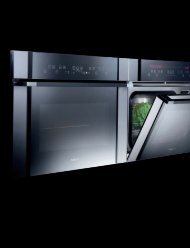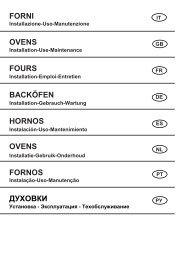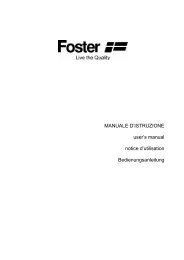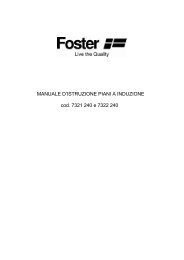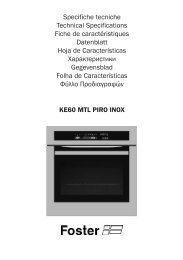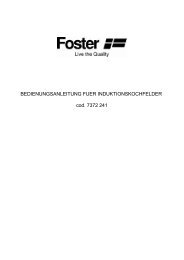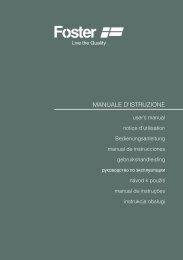users_manual_microgrill_s4000_7136_020.pdf - Foster S.p.A.
users_manual_microgrill_s4000_7136_020.pdf - Foster S.p.A.
users_manual_microgrill_s4000_7136_020.pdf - Foster S.p.A.
You also want an ePaper? Increase the reach of your titles
YUMPU automatically turns print PDFs into web optimized ePapers that Google loves.
What kind of ovenware can be used?<br />
Microwave function<br />
For the microwave function, keep in mind that<br />
microwaves are reflected by metal surfaces.<br />
Glass, china, clay, plastic, and paper let<br />
microwaves pass.<br />
For this reason, metal pans and dishes or<br />
containers with metal parts or decorations<br />
cannot be used in the microwave. Glass ware<br />
and clay with metallic decoration or content<br />
(e.g. lead crystal) cannot be used in microwave<br />
ovens.<br />
The ideal materials for use in microwave ovens<br />
are glass, refractory china or clay, or heat<br />
resistant plastic. Very thin, fragile glass or china<br />
should only be used for short period of times (e.g.<br />
heating).<br />
Hot food transmits heat to the dishes which can<br />
become very hot. You should, therefore, always<br />
use an oven glove!<br />
How to test ovenware you want to use<br />
Put the item you want to use in the oven for 20<br />
seconds at maximum microwave power. After that<br />
time, if it is cold and just slightly warm, it is<br />
suitable to use. However, if it heats up a lot or<br />
causes electric arcing it is not suitable for<br />
microwave use.<br />
Grill function<br />
In the case of the grill function, the ovenware must<br />
be resistant to temperature of at least 300°C.<br />
Plastic dishes are not suitable for use in the grill.<br />
Microwave + grill function<br />
In the microwave + grill function, the ovenware<br />
used must be suitable for use in both the<br />
microwave and the grill.<br />
Aluminium containers and foil<br />
Pre-cooked food in aluminium containers or in<br />
aluminium foil can be put in the microwave if the<br />
following aspects are respected:<br />
EN<br />
• Keep in mind the manufacturer’s<br />
recommendations written on the packaging.<br />
• The aluminium containers cannot be more<br />
than 3 cm high or come in contact with the<br />
cavity walls (minimum distance 3 cm). Any<br />
aluminium lid or top must be removed.<br />
• Put the aluminium container directly on top<br />
of the turntable plate. If you use the grid iron,<br />
put the container on a china plate. Never put<br />
the container directly on the grid iron!<br />
• The cooking time is longer because the<br />
microwaves only enter the food from the top.<br />
If you have any doubts, it is best to use only<br />
dishes suitable for microwave use.<br />
• Aluminium foil can be used to reflect<br />
microwaves during the defrosting process.<br />
Delicate food, such as poultry or minced<br />
meat, can be protected from excessive heat<br />
by covering the respective<br />
•<br />
extremities/edges.<br />
Important: aluminium foil cannot come into<br />
contact with the cavity walls since this may<br />
cause electrical arcing.<br />
Lids<br />
We recommend you use glass or plastic lids or<br />
cling film since:<br />
1. This will stop excessive evaporation (mainly<br />
during very long cooking times);<br />
2. The cooking times are shorter;<br />
3. The food does not become dry;<br />
4. The aroma is preserved.<br />
The lid should have holes or openings so that no<br />
pressure develops. Plastic bags must also be<br />
opened. Baby feeding bottles or jars with baby<br />
food and similar containers can only be heated<br />
without their tops / lids otherwise they can burst.<br />
25




